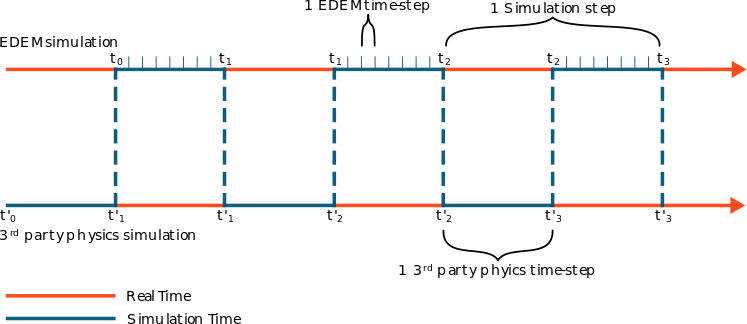Coupling Interface Programming Guide
The Coupling Interface Programming Guide provides an overview of how to use the EDEM Coupling Interface to couple with a generic CFD code and/or Multi Body dynamics codes.
The EDEM Coupling Interface class,
IEDEMCoupling.h contains programming implementation information for
the interface. The EDEM Coupling Interface enables users to
construct coupled fluid - particle simulations between CFD codes and EDEM, coupled simulation between rigid/Multi Body dynamics codes
and EDEM or couple EDEM to
programs that you have written. The Coupling Interface enables two independent programs
to operate synchronously, sharing data to create a single ‘coupled’ simulation.

Coupling Simulation Sequence
During a coupled EDEM simulation, EDEM and the coupled 3rd party code simulate in an alternating manner, with the 3rd party code first. The 3rd party code will simulate ahead in time and then pass any required data to EDEM for it to be allowed to simulate to the same point in time. This alternating pattern continues until the simulation time has reached the specified end time, shown in the following image. Due to the explicit time integration methods implemented in EDEM, it is common that multiple Time Steps are required to simulate the same time period as a single Time Step of either a CFD or Multi Body dynamics simulation. Therefore, Time Steps between the two solvers are potentially different, though the simulation-steps are the same.

Each time the EDEM Coupling Interface sends a message to EDEM, it blocks further messages from being sent until EDEM returns a response. This synchronous behavior effectively pauses the 3rd party code until EDEM has calculated the required simulation step.
EDEM Coupling Interface Packaging
The EDEM Coupling Interface comprises client and server components. The server component resides within EDEM, and the client component is to be used by the 3rd party code to interact with EDEM. The EDEM Coupling Client Interface class provides a number of methods for setup, simulation, and data control.

Custom Particle Property Unit Types
| Unit Type | Identifier | SI Unit |
|---|---|---|
| Other | 0 | Unknown unit |
| None | 1 | Unitless |
| Acceleration | 2 | m/s2 |
| Angle | 3 | Rad |
| Angular Acceleration | 4 | rad/s2 |
| Angular Velocity | 5 | rad/s |
| Density | 6 | kg/m |
| Energy | 7 | J |
| Work Function | 8 | J |
| Force | 9 | N |
| Charge | 10 | C |
| Length | 11 | m |
| Mass | 12 | kg |
| Moment of Inertia | 13 | kg/m2 |
| Shear Modulus | 14 | Pa |
| Time | 15 | s |
| Torque | 16 | Nm |
| Velocity | 17 | m/s |
| Volume | 18 | m3 |
| Frequency | 19 | Hz |
| Temperature | 20 | K |
| Heat Flux | 21 | W |
| Stiffness | 22 | N/m |
| Stress | 23 | Pa |
| Mass Flow | 24 | kg/s |
| Stiffness per Unit Area | 25 | N/m3 |